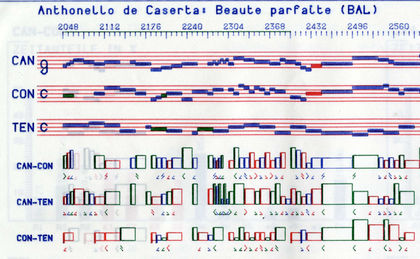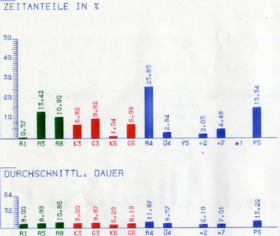Difference between revisions of "Archive of Digital Applications in Musicology (ADAM)"
| Line 10: | Line 10: | ||
* [[DARMS]] — Digital Alternative Representation of Musical Scores (DARMS) | * [[DARMS]] — Digital Alternative Representation of Musical Scores (DARMS) | ||
| − | |||
| − | |||
* [[Fastcode]] — Fastcode | * [[Fastcode]] — Fastcode | ||
Revision as of 00:21, 10 October 2015
UNDER DEVELOPMENT
The aim of ADAM is to preserve information about projects in digital musicology that were ground-breaking in their time but lack a substantial online presence. Projects end for a variety of reasons—discontinuation of funding, insurmountable changes of technology, or the retirement of a director. These projects remain stand-outs for the careful musical thinking that underlies them and the innovative approaches they introduced. For curated digital and hybrid editions, see EVE: Electronic and Virtual Editions. Also see Digital Resources for Musicology.
Contents
Encoding Systems
Click the link to find a description of these systems:
- DARMS — Digital Alternative Representation of Musical Scores (DARMS)
- Fastcode — Fastcode
- Mustran — Mustran
- IML-MIR — Intermediate Musical Language - Music Information Retrieval (IML-MIR)
- SMUT — System for Music Transcription (SMUT)
- Teletau — Telematics on the TAU system (Teletau)
- ZIPI — ZIPI Music Parameter Description Language
Analysis-oriented projects
Essen Associative Code (EsAC)
Website: EsAC: Goals, History, Manuals
The Essen Associative Code for folk-song research was actively maintained by its developer, Helmut Schaffrath (1942-1994), and, after his death by Ewa Dahlig. Its encoded materials are now mainly used (after translation to other codes) to test algorithms for melodic search and folksong analysis. The software developed by Schaffrath and his collaborators was particularly intended to observe conventions of traditional-music research, including adherence to strict rules for phrase segmentation (based on underlying texts) and a freedom of restrictions in defining scales and "tonalities". Lyrics are not normally contained within EsAC music encoding, but an exception was made for some Norwegian and Polish folksongs. In these cases adaptations of the code were required to accommodate multiple syllables sung on one pitch (and the reverse). (Conventional EsAC is strictly monophonic and the addition of lyrics in essence creates a second stream of information.) While little new encoding in EsAC has occurred over the past decade, several large corpora of nineteenth-century typescript encodings of folksongs in Central Europe suggest that preservation of a knowledge of EsAC is essential to the interests of future ethnography.
Research of Norbert Böker-Heil
The German systematic musicologist Norbert Böker-Heil carried out numerous trials of computer-assisted research in multiple German locations in the 1970s and 1980s. Seizing every opportunity to explore mainframe computer use for musicological purposes, he delved into music printing, database development, and music analysis, always with a focus on repertories of the later middle ages and early Renaissance. Apart from his noted multi-volume survey of sources for the Tenorlied (1979-1988) and his collaborations with other scholars on the integration of textual and musical information, he explored computer-driven sound synthesis (1983) before the establishment of MIDI protocols; outlined the computer possibilities of the RISM AII (manuscript inventory) project (1975) two decades before there was public access to the internet; developed a system for input and plotter output of white mensural notation (1971); producing a near facsimile of the original notation; sought to develop a tool to automatically identify musical structure in polyphonic music (1972); and help up a beacon to future researchers in his thoughts on problems that computer-based researcher would encounter as machine capabilities improved.
Among his most sophisticated projects were the color-coded music-analysis tools he developed for fourteenth-century music in his later years at the Staatliches Institut für Musikforschung in Berlin. From his substantial, multi-faceted evaluations of particular Tenorlieder we are able to reproduce this series of images from his work on Anthonello de Caserta's "Beaute parfaite". The composer came from the generation following Machaut and lived around 1500. Böker-Heil explores (1) rhythmic and pitch movement in this three-voice work and the kinds of intervals that occur between voices; (2) the three-part harmonies that occur in specified time-slices; and (3) contrapuntal details deriving average duration and phrase length. (Each "view" consists of two panels, as there was no way at the time to scale output.)
Encoded score archives
Werner Icking Music Archive (WIMA)
The recent history of the Werner Icking Music Archive. Icking and several colleagues developed a music-printing capability that was modeled on the TeX metafont and typesetting system. He built an online capability for users to share scores they had edited and typeset themselves. In many cases this included full sets of parts. Some editions were arrangements. MusiTeX (and related dialects) were often traded within the community, but some of the contributions predated the widespread use of the internet. After Icking's death (2001), his archive was administered by a contributor, Christian Mondrup. In 2011-12 it was amalgamated with the IMSLP aggregation. Icking offered an important prototype for current score-interchange sites.
Return to Digital Resources in Musicology

